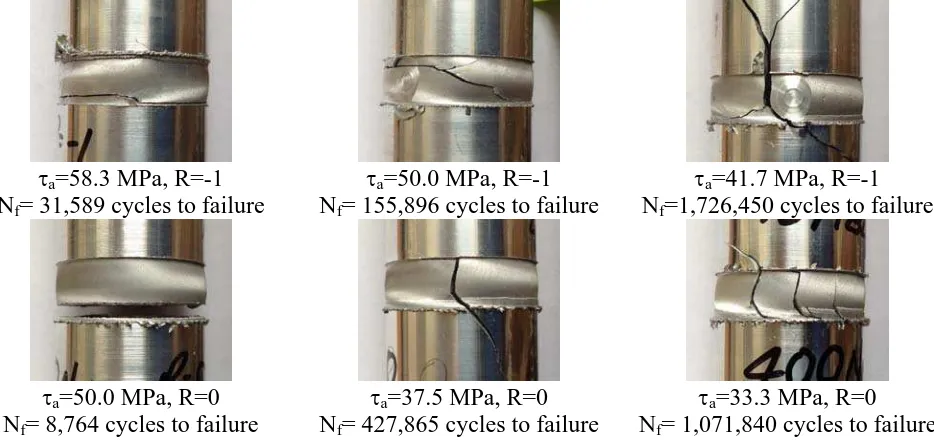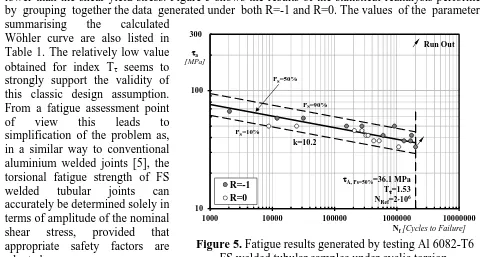This is a repository copy of Fatigue behaviour of Al 6082-T6 friction stir welded tubular joints under torsional loading.
White Rose Research Online URL for this paper: http://eprints.whiterose.ac.uk/90845/
Version: Accepted Version
Article:
Hattingh, D.G., James, M.N., Susmel, L. et al. (1 more author) (2014) Fatigue behaviour of Al 6082-T6 friction stir welded tubular joints under torsional loading. Key Engineering Materials, 627. 193 - 196. ISSN 1013-9826
https://doi.org/10.4028/www.scientific.net/KEM.627.193
eprints@whiterose.ac.uk https://eprints.whiterose.ac.uk/ Reuse
Unless indicated otherwise, fulltext items are protected by copyright with all rights reserved. The copyright exception in section 29 of the Copyright, Designs and Patents Act 1988 allows the making of a single copy solely for the purpose of non-commercial research or private study within the limits of fair dealing. The publisher or other rights-holder may allow further reproduction and re-use of this version - refer to the White Rose Research Online record for this item. Where records identify the publisher as the copyright holder, users can verify any specific terms of use on the publisher’s website.
Takedown
If you consider content in White Rose Research Online to be in breach of UK law, please notify us by
Fatigue Behaviour of Al 6082-T6 Friction Stir Welded Tubular Joints
under Torsional Loading
D. G. Hattingh
1,a, M. N. James
1, 2,b, L. Susmel
3,c, R. Tovo
4,d1Department of Mechanical Engineering, Nelson Mandela Metropolitan University,
Private Bag X6011, Port Elizabeth 6000, South Africa
2School of Engineering, University of Plymouth, Drake Circus, Devon PL4 8AA, England, UK
3Department of Civil and Structural Engineering, University of Sheffield, Sheffield S1 3JD, UK
4Department of Engineering, University of Ferrara, via Saragat 1, 44100 Ferrara, Italy
a
danie.hattingh@nmmu.ac.za, bm.james@plymouth.ac.uk,
c
l.susmel@sheffield.ac.uk, droberto.tovo@unife.it
Keywords: Friction stir welding, torsional fatigue, Al 6082-T6
Abstract. The aim of the present research is to investigate the fatigue behaviour of friction stir (FS)
welded tubular joints in aluminium alloy subjected to torsional fatigue loading. To manufacture the samples which were tested, an MTS I-STIR process development system was equipped with a retracting tool specifically designed for these tubular welds. Al 6082-T6 FS welded samples were tested under cyclic torsion with a nominal shear stress ratio equal to -1 and 0. The test data show that, strictly speaking, the presence of non-zero mean shear stresses has a detrimental effect on the overall torsional fatigue strength of the FS welded joints. However, the reanalysis discussed in the present paper suggests that, from a statistical point of view, any detrimental effect is small. This means that fatigue assessment under torsional fatigue loading of these FS welded tubular connections can be performed with little loss of accuracy by neglecting the presence of non-zero mean shear stresses.
Introduction
One of the most difficult technological issues in designing a high-performance mechanical assembly is achieving efficient and reliable joining of the different parts. Welding is now the most widely used joining solution, but suffers from a number of issues related to flaws induced during welding and to the thermal cycle experienced by material local to the weld. Weld design, e.g. to Eurocode 3 (steel) [1] or Eurocode 9 (aluminium) [2], therefore relies on statistically reliable although very conservative experimental data together with a fracture mechanics analysis of crack growth from assumed initial flaws. Weld quality is a very significant variable which is largely left unspecified in current generation fusion welding codes. FS processes are a fairly recent solid-state alternative offering high quality, low residual stress welds with high fatigue strength. These advantages mean that FS welding is a technological process that is already widely applied in the industrial arena for structures/components where service life is not dominated by dynamic loading. The major barrier to a wider adoption of aluminium FS welded joints in dynamically loaded structures is the lack of suitable multiaxial design procedures. As a first step towards progress in this complex scenario, the present paper summarises experimental results generated by testing Al 6082-T6 FS welded tubular joints under cyclic torsion. The work presented here is part of a larger programme of work on the issue of multiaxial fatigue design for FW welded tubular structures.
Development of the technological process to FS weld tubular joints
process to determine values for the manufacturing process variables, FS welds of high quality could be made in small diameter aluminium tubes. Figure 2 shows a typical welded Al 6082-T6 aluminium specimen manufactured using this technology. The FS welded tubular samples employed in the present investigation had outer nominal diameter equal to 38 mm and inner nominal diameter to 31 mm. Both the static and fatigue results were generated by testing samples in the as-welded condition.
Static strength under axial and torsional loading
In order to check the reliability and repeatability of mechanical properties of these specimens (which is an indicator of weld quality) a number of tensile tests were carried out under pure tension as well as under pure torsion.
Figure 1. Platform specifically
developed to manufacture FS welded tubular joints.
Figures 3a and 3b show two tensile curves generated under axial and torsional loading, respectively. As expected, failures were seen to take place at the tip of the undercut resulting from the FS welding process (see the images in Figure 3). As a further check of the tensile strength, data were also acquired from microtensile quasi-flat specimens using a Gatan Microtest 2000EW test stage. This investigation, done at the University of Plymouth, UK, was in preparation for future electron back-scatter diffraction work on microstructural changes during fatigue crack growth. The experimental investigations performed in the two laboratories resulted in an average value of the ultimate tensile strength for FS welded Al 6082-T6 equal to 152 MPa, the axial static strength of the parent material being equal to 303 MPa.
Fatigue strength under torsional loading
The torsional fatigue tests used a SCHENCK servo-hydraulic axial/torsional testing machine. The welded specimens were clamped using MTS hydraulic grips and the torsional tests were carried out under nominal torsional load ratios (R=min/max)
Figure 2. Al 6082-T6 FS
welded tubular specimen.
equal to -1 and 0. The failure criterion that was adopted was a 10% torsional stiffness decrease, equivalent to cracks having a length of about 30 mm. The pictures seen in Figure 4 show the typical cracking behaviours displayed by the FS welded joints. Irrespective of the applied load ratio, cracks were seen to initiate mainly at weld undercut, with subsequent propagation occurring on those planes that experienced the maximum shear stress amplitude (i.e. on planes either parallel or perpendicular to the specimens’ axis). It is important to highlight that, under torsional loading, the weld end points (see Figure 2) did not act as preferential locations for crack initiation, with 15 out of 18 specimens failing due to fatigue cracks that were initiated away from the weld end points.
The Wöhler diagram in Figure 5 reports, in terms of nominal shear stress amplitude, a, the data
generated under a torsional load ratio, R, equal to both -1 and 0. The results of the statistical reanalysis are summarised in Table 1, where k is the negative inverse slope, A is the amplitude of
the endurance limit extrapolated at NRef=2106 cycles to failure, and T is the scatter ratio of the
amplitude of the endurance limit for 90% and 10% probabilities of survival, PS. The experimental
results were post-processed under the hypothesis of a log-normal distribution of the number of cycles to failure for each stress level with a confidence level of 95% [3].
Figure 3. FS welded tubes tested under axial (a) and torsional (b) static loading.
a=58.3 MPa, R=-1
Nf= 31,589 cycles to failure
a=50.0 MPa, R=-1
Nf= 155,896 cycles to failure
a=41.7 MPa, R=-1
Nf=1,726,450 cycles to failure
a=50.0 MPa, R=0
Nf= 8,764 cycles to failure
a=37.5 MPa, R=0
Nf= 427,865 cycles to failure
a=33.3 MPa, R=0
Nf= 1,071,840 cycles to failure
Figure 4. Examples of the observed macroscopic cracking behaviour.
The negative inverse slopes (Table 1) are characterised by larger values than the one recommended by the International Institute of Welding (IIW) to design conventional aluminium welded joints against torsional fatigue (i.e. k=5) [5]. The values for k reported in Table 1 are also larger than the unifying value of 7 suggested by LBF in Darmstadt, Germany to perform, according to the reference radius concept, the torsional fatigue assessment of
N. of
samples R k
A
T
[MPa]
11 -1 10.8 38.9 1.49
9 0 9.5 32.9 1.52
20 -1 & 0 10.2 36.1 1.53
Table 1. Summary of the experimental results
generated under torsional fatigue loading.
conventional aluminium welded connections which can be classified as “thin and flexible” [6]. This seems to indicate that the local stress concentration phenomena due to the undercut occurring during FS welding has little effect under cyclic torsion, resulting in negative inverse slopes approaching the values usually displayed by un-welded aluminium alloys [7].
The endurance limits, A, reported in Table 1 also indicate that the presence of superimposed
[image:4.595.68.535.268.488.2]lower than the shear yield stress. Figure 5 shows the results of the statistical reanalysis performed by grouping together the data generated under both R=-1 and R=0. The values of the parameters summarising the calculated
[image:5.595.52.532.102.359.2]Wöhler curve are also listed in Table 1. The relatively low value obtained for index T seems to strongly support the validity of this classic design assumption. From a fatigue assessment point of view this leads to simplification of the problem as, in a similar way to conventional aluminium welded joints [5], the torsional fatigue strength of FS welded tubular joints can accurately be determined solely in terms of amplitude of the nominal shear stress, provided that appropriate safety factors are adopted.
Figure 5. Fatigue results generated by testing Al 6082-T6
FS welded tubular samples under cyclic torsion.
Conclusions
The welding process developed in this research project produces high quality FS welds in aluminium tubular joints. This novel advance in technology is expected to have high industrial impact in the near future.
From a design point of view, the torsional fatigue strength of tubular welded joints in 6082-T6 alloy can be accurately estimated by neglecting the presence of non-zero mean shear stresses, provided that appropriate safety factors are adopted.
Acknowledgements
The Leverhulme Trust (www.leverhulme.ac.uk) is acknowledged for fully supporting the present research investigation (Project’s Reference Number: IN-2012-107). Thanks are also due to Mr M. Renninson who gave invaluable support to perform the tests under cyclic torsion.
References
[1] Anon.:EUROCODE 3 – Design of steel structures, ENV 1993-1-1 (1988). [3] Anon.: EUROCODE 9 - Design of aluminium structures, prENV (1999).
[3] J.E. Spindel, E. Haibach, in: Statistical Analysis of Fatigue Data, edited by R. E. Little and J.C. Ekvall, ASTM STP 744, pp. 89-113 (1981).
[4] E. Haibach: Service fatigue-strength – methods and data for structural analysis (VDI, Düsseldorf, Germany 1992).
[5] A. Hobbacher: IIW document XIII-2151-07/XV-1254-07 (2007).
[6] C.M. Sonsino, T. Bruder, J. Baumgartner: IIW-Doc. No. XIII-2280 (2009)/XV-1325 (2009) [7] L. Susmel: Multiaxial Notch Fatigue (Woodhead & CRC, Cambridge, UK 2009).
[8] G. Sines, in: Metal fatigue, edited by G. Sines, J.L. Waisman, McGraw-Hill, New York, US, pp. 145–69 (1959).
10 100
1000 10000 100000 1000000 10000000
a
[MPa]
Nf[Cycles to Failure]
R=-1 R=0
PS=90%
PS=50%
A, Ps=50%=36.1 MPa T=1.53
NRef=2106 k=10.2
PS=10%
[image:5.595.237.523.135.334.2]
